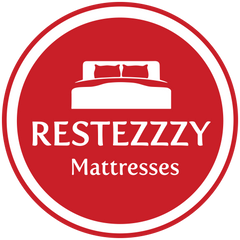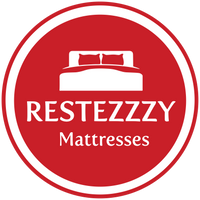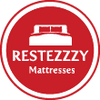Senior Sleep: The Best Mattresses for Senior Citizens

💤 Introduction
For adults of any age, sleep is necessary to perform daily activities, however, the importance of sleep increases as one gets older. In older adults, quality sleep functions to enhance memory, facilitate physical recuperation, lift one’s mood, and promote general health. Unfortunately, seniors suffer sleep problems, due to discomfort, pain, and restlessness from conditions like aging joints, unsupportive mattresses, or underlying medical conditions.
At Restezzzy Mattresses, we appreciate how mattresses can make the difference between waking up refreshed, and free from pain or stiff and sore. In this guide, we discuss the best types of mattresses for older adults, and how each enhances comfort, encourages mobility, and improves general health..
1. How Sleep Changes with Age
It’s normal for sleep patterns to evolve as we get older. Many seniors find they sleep lighter, wake more frequently, or struggle to fall asleep in the first place. Several factors contribute to this shift:
-
Sleep cycle changes: Less time is spent within the deep, restorative stages of sleep.
-
Sleep Discomfort: Conditions like arthritis, back pain, or stiff joints can make it tough to find a comfortable sleeping position.
-
Age-associated medical conditions: Sleep apnea and other conditions like reflux and circulatory issues which affect sleep become more prevalent with aging.
-
Medication effects: Some medications can inhibit deep sleep or cause the user to wake up at night.
-
Temperature: Older adults are more sensitive to changes in environmental temperature.
Having a well designed and made mattress can, to a great extent, alleviate most of the issues described, with the result being pain-free, restorative sleeping. Re the last point, older adults feel and become sleep more easily.
2. What Older Adults Should Look for in a Mattress
Before diving into mattress types, it’s helpful to understand the key features that make a mattress senior-friendly. These characteristics can turn restless nights into deep, restorative sleep.
a. Pressure Relief
For older customers, mattress shopping should include mats that help relieve pain. Pressure relief mats can help with pain that falls on the hips, shoulders, lower backs, and joints by helping them align. Latex and foam mats are the best at this because they take on the shape of the customers.
b. Support and Spinal Alignment
Proper spine alignment is crucial in relieving pain. A soft mattress will not provide the support needed and will cause the spine to sag while a firm mattress will cause uncomfortable pressure by creating a pinch. The ideal mattress will keep a spine in a natural curve by providing gentle support.
c. Ease of Movement
Mobility is another concern for seniors — especially those with arthritis or reduced flexibility. A mattress that’s too soft can make it difficult to change positions or get out of bed. Mattresses with a bit of bounce (like hybrids or latex) allow easier movement and transition.
d. Temperature Regulation
Several older adults have difficulty finding a comfortable sleeping temperature, whether it be too warm or too cold. For a comfortable night's sleep, a mattress temperature-regulating features, such as breathable materials, open cell foam, and cooling gels.
e. Edge Support
Strong edges provide stability for sitting, getting in and out of bed, and using the entire sleep surface. Mattresses with reinforced borders or coil systems tend to perform best here.
f. Compatibility with Adjustable Bases
An adjustable base can really help older adults who sleep, as it allows them to elevate their heads or legs to help with snoring, reflux, and circulation. Not all types of mattresses work well with adjustable bases, which is something to keep in mind.
3. The Best Mattress Types for Older Adults
Now let’s explore the most suitable mattress types for seniors — what they’re made of, their pros and cons, and who they’re best for.
1. Memory Foam Mattresses
Overview:
Memory foam is one of the most popular materials for seniors because of its excellent pressure relief and contouring ability. Originally developed by NASA, it adapts to your body’s curves, distributing weight evenly and minimizing joint stress.
Benefits for Seniors:
-
Outstanding pressure relief: Perfect for reducing pain in hips, shoulders, and joints.
-
Motion isolation: Ideal for couples — movements on one side of the bed won’t disturb the other.
-
Good spinal alignment: Foam adjusts to your posture, promoting healthy alignment.
-
Quiet design: No squeaks or creaks when moving.
Potential Drawbacks:
-
Some memory foams trap heat, although modern versions include cooling gels or open-cell designs.
-
The dense foam structure can make it a bit harder for some seniors to move or get up, especially in very soft models.
Best for: Seniors with chronic pain, arthritis, or who prefer a cushioned, cradling feel.
2. Latex Mattresses
Overview:
Natural latex mattresses offer a perfect balance of comfort and support. They provide gentle contouring like memory foam but with more bounce and breathability. Latex is also hypoallergenic, making it great for sensitive sleepers.
Benefits for Seniors:
-
Supportive yet responsive: Easy to move on — ideal for seniors with limited mobility.
-
Durable: Latex mattresses can last 10–15 years without sagging.
-
Cooling properties: Naturally temperature-neutral and breathable.
-
Eco-friendly: Many latex models are made from natural, sustainable materials.
-
Low maintenance: Resistant to dust mites and mold.
Potential Drawbacks:
-
Latex mattresses can be heavier, which may make rotating or moving them difficult without assistance.
-
They tend to be more expensive, but their longevity offsets the higher cost over time.
Best for: Seniors who want a supportive, cool, and responsive surface that’s easy to move on.
3. Hybrid Mattresses
Overview:
Hybrid mattresses combine the best of both worlds — foam layers for comfort and coil systems for support. This design offers targeted pressure relief without sacrificing bounce or edge stability.
Benefits for Seniors:
-
Excellent balance of support and cushioning: Ideal for both back and side sleepers.
-
Easy mobility: Coils provide a gentle bounce, helping seniors move or sit up more easily.
-
Great airflow: Coil systems enhance ventilation, keeping the bed cool.
-
Strong edge support: Perfect for those who sit at the edge of the bed.
Potential Drawbacks:
-
Heavier than foam-only models.
-
Quality can vary depending on the coil system and foam density.
Best for: Seniors who want both softness and support — particularly couples or combination sleepers.
4. Innerspring Mattresses
Overview:
Traditional innerspring mattresses use metal coils for support with a layer of padding or foam on top. Modern designs are more comfortable than the old-fashioned versions, offering good airflow and solid support.
Benefits for Seniors:
-
Firm and supportive: Great for seniors who prefer a traditional, bouncy feel.
-
Easy to move on: The spring system adds responsiveness.
-
Cooler sleep: Air circulates easily through the coils.
-
Affordable: Generally less expensive than foam or latex models.
Potential Drawbacks:
-
Limited pressure relief compared to foam or hybrid designs.
-
Coils may create motion transfer — not ideal for light sleepers.
-
Lifespan tends to be shorter than foam or latex mattresses.
Best for: Seniors who want a firmer, more traditional mattress or who tend to sleep hot.
4. Choosing the Right Mattress Based on Sleep Position
Your sleeping position also plays a big role in determining the best mattress type:
-
Back Sleepers: To maintain the best spinal alignment, go for medium-firm hybrids or latex mattresses.
-
Side Sleepers: Softer-to-medium memory foam or hybrid models alleviate pressure on the shoulders and hips.
-
Stomach Sleepers: To avoid the lower back sagging, go for medium-firm latex or innerspring options.
-
Combination Sleepers: For easy position changes, responsive latex or hybrid mattresses are excellent.
At Restezzzy Mattresses, we frequently suggest hybrids or latex models for older adults, as it meets comfort, support, and ease of movement, which are critical for this population.
5. Additional Tips for Better Senior Sleep
A mattress alone can’t solve every sleep problem, but it’s a powerful start. Here are some bonus tips to help seniors sleep better:
-
Pair with an adjustable base: Elevating the head or feet can help with snoring, acid reflux, and swelling.
-
Use breathable bedding: Cotton or bamboo sheets improve temperature regulation.
-
Maintain a consistent sleep routine: Going to bed and waking up at the same time helps with natural sleep cycles.
-
Check mattress height: A mattress that’s too low or too high can complicate getting in and out of bed.
-
Replace old mattresses: Most mattresses lose support after 7–10 years. If you wake up sore, it might be time for an upgrade.
Conclusion
Sleep quality for older adults is complemented by health and overall happiness, while mobility is increased with good sleep quality. The spine aligned and pressure points eased makes for comfortable nights, and with the right mattress, this is easy.
The right mattress can change how you sleep, and how you feel at the start of the day, whether you appreciate the contouring comfort of memory foam, the buoyant support of latex, or the balanced feel of a hybrid.
At Restezzzy Mattresses, our goal is simple: to help every sleeper, at every age, rest easy. Visit our store or explore our online collection to find a mattress that supports not just your back, but your lifestyle, comfort, and peace of mind.




Leave a comment